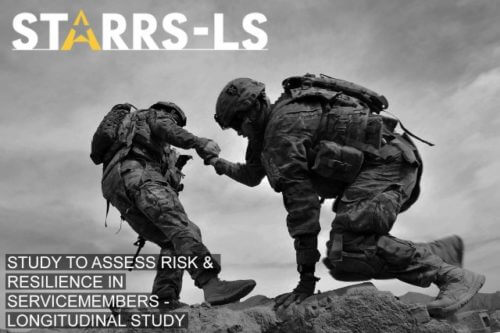Women who join the Army at age 25 or older are the most likely Soldiers to attempt suicide during their first years of service, researchers found. Soldiers who have not yet deployed are also more likely to attempt suicide than their more experienced counterparts.
These are among a host of findings from the Army’s multi-year “Study to Assess Risk and Resilience in Service members,” known as STARRS.
At the same time, the research found that women and Soldiers who never deployed are actually not the most likely to die by suicide. Soldiers who use firearms in their suicide attempts are more likely to end up as fatalities, while women are more likely to attempt suicide by drug overdose, with a better chance of rescue.
STARRS, which began in 2009, was actually a grouping of eight different studies conducted for the Army by the National Institute of Mental Health, along with several universities. Harvard Medical School, the University of Michigan and the University of California-San Diego all participated in the study.
STARRS examined the records of 1.6 million Soldiers on active duty from 2004 to 2009. It also collected new information directly from more than 110,000 Soldiers at various points in their careers, from 2010 to 2014.
Participants included new Soldiers in basic training, established Soldiers in units around the world, and members of several brigade combat teams before and after deploying to Afghanistan.
LONGITUDINAL STUDY
Of the 110,000 Soldiers researchers contacted directly for information as part of STARRS, 72,000 agreed to be contacted again in the future to provide additional information. They form the core study group for the ongoing STARRS-Longitudinal Study.
The data are still being culled and research continues under STARRS-LS. This study, funded by the Department of Defense, will continue through 2020.
STARRS-LS will continue following the 72,000 Soldiers throughout their careers and collect more data from other Soldiers, even after they transition back to civilian life. A primary focus will be to identify risk and protective factors for suicide.
STARRS began as an action-oriented science effort, said Dr. Robert J. Ursano, a lead for the study at the Uniformed Services University of the Health Sciences.
“It is actionable science,” he said. “It is science meant to solve problems.”
The findings are being summarized in scientific and medical journals. Seven years into the research, at least 35 journal articles have been published and several more are undergoing peer review now.
“That’s where the real meat and potatoes is for what’s come out of STARRS,” said Dr. Kenneth Cox of the Army Public Health Center (Provisional), another scientist involved in the studies.
STARRS-LS also intends to “dig deeper” into three specific groups: female Soldiers, Special Forces troops and Reserve-component Soldiers, Cox said.
SEARCHING FOR NEEDLES IN HAYSTACKS
“Suicide is a complex problem,” said Michael Schoenbaum, a scientist at NIMH who has been involved in the STARRS research from the beginning.
“In a certain way, suicide is like needles in a haystack,” he said. “The Army is a big haystack and there are too many needles [suicides], but in statistical terms, [suicide] is still a rare outcome.”
The goal of STARRS, Schoenbaum said, is to use data to sort the population. Instead of looking at all Soldiers, the Army will focus instead on a smaller percentage deemed to be high risk.
“We have demonstrated that this is possible,” Schoenbaum said.
Employing linear regression and machine learning, using models and algorithms, the research teams have been able to identify high-risk populations.
PREDICTIVE ANALYTICS
Schoenbaum said it’s possible to identify segments of the Army that are most at risk for suicide using the same kind of approach credit card companies use to identify fraud.
When credit card companies detect irregular spending on a customer’s credit card, they contact that customer to verify those purchases. While it sometimes turns out that a customer’s card has not actually been stolen, a percentage of those calls do end up alerting users to card theft.
When it comes to suicide, relationship issues, stress, alcohol or drug abuse, getting passed up for promotion, financial problems, suffering traumatic brain injury or undergoing hospitalization for psychiatric issues are all irregular factors that might predict a suicide attempt.
While most Soldiers with those symptoms or problems will never commit suicide, Schoenbaum said, that group of Soldiers is at higher risk for attempting suicide.
“We’re not trying to identify Private Smith, the ticking time bomb … our goal is to identify a thousand people with a higher concentration [of risk factors],” he said.
CONCENTRATION OF RISK
Researchers also found that infantrymen and combat engineers have a higher risk of suicide than Soldiers in other military occupational specialties. What’s more, Cox said, infantrymen were subject to the highest risk before deploying and their risk factor dropped somewhat after arriving in theater.
Soldiers in other MOSs were just the opposite: their risk of suicide was highest while deployed, Cox said.
Infantrymen have higher risk factors across the board, though.
“We recruit people who like sports, who jump off of things, who bang their heads on things,” Ursano said.
Infantrymen also have a higher probability of suffering accidents and fatalities other than suicides, he said, based on their tendency toward more dangerous activities both on and off duty.
“These are really demonstrations of the possibility,” Ursano said. “They aren’t finalized tools, but [they demonstrate the] ability to predict.”
ACTIONABLE FINDINGS
While there is no magic pill to prevent suicides, intervention tools are being developed by researchers such as Dr. Thomas Joyner at Florida State University and Dr. Peter Gutierrez at the University of Colorado School of Medicine, Ursano said.
While that effort is not part of the STARRS family of studies, he said, it is parallel research.
In addition, a team is putting together recommended actions that the Army might take to prevent suicides based on the STARRS research. Ursano said the assistant secretary of the Army for Manpower and Reserve Affairs will soon be presented with the implementation plan.


